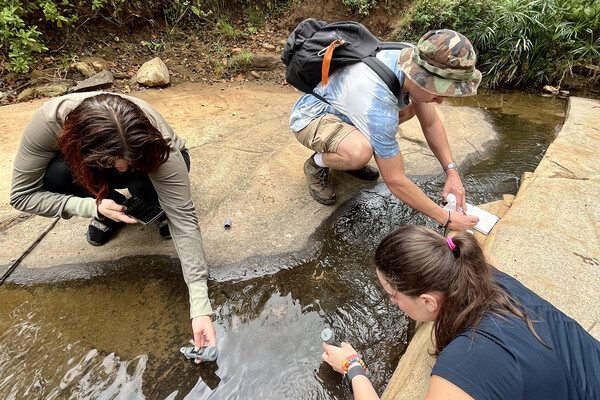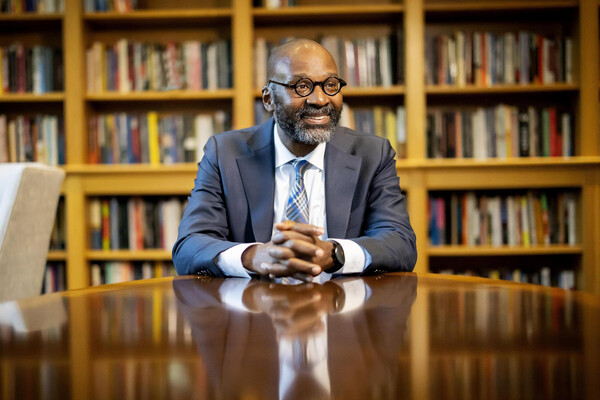
Griffin Pitt, right, works with two other student researchers to test the conductivity, total dissolved solids, salinity, and temperature of water below a sand dam in Kenya.
(Image: Courtesy of Griffin Pitt)

The holiday season brings a renewed attention to giving and with it, competing demands on donors’ time and attention. That’s where the Center for High Impact Giving (CHIP) comes in, says Katherina “Kat” Rosqueta of the School for Social Policy & Practice (SP2). “For us, it’s all about getting people off the sidelines. Everybody can practice high impact philanthropy,” she says. “High impact philanthropy is not about the amount you give. It’s about giving in a way that leads to a better, stronger, safer, more vibrant world.”
CHIP creates an annual tool kit to help donors do just that. The theme of this year’s high impact giving guide is “a more secure future for all,” says Rosqueta, CHIP’s founding executive director.
Almost three years into the COVID-19 pandemic, people are returning to work, and “it’s feeling a little more normal,” she says. Yet, for others, the future is still uncertain. The pandemic, along with inflation and economic pressures, has contributed to precarity, Rosqueta says.
In the coming year, CHIP is concentrating on expanding educational opportunities, financial security, addressing structural inequality, strengthening democracy, and promoting effective disaster response.
The COVID-19 pandemic disrupted learning for children of all ages. “There’s now a lot of research around findings that remote learning wasn’t good,” Rosqueta says. “It was particularly bad for children in resource-poor settings who didn’t have supports like a place to learn, reliable WiFi, or parents who could stay home and basically become their teachers.” Even if learning losses from the COVID pandemic are recovered, there remains a learning gap between children from low-income families and their middle-class counterparts, she says.
“We want everybody to have a more secure future,” Rosqueta says. “That means accelerating gains, so that young people have the educational opportunities that we know are tied to life opportunities.”
How can philanthropy help? “All children need a web of support to develop their full potential,” Rosqueta says. “That web of support consists of the adults in their lives—parents, caregivers, teachers, and others—who help them meet their physical, social, emotional, and academic needs.” CHIP gives the example of All Our Kin, a nonprofit that provides training and support to family childcare educators for what Rosqueta calls “a triple benefit: providing children with better early childhood learning experiences, helping their parents stay in the workforce, and strengthening the finances of child care business owners.”
“Even though businesses are opening and more people are working, we are still feeling the financial effects of COVID,” says Rosqueta. Add inflation to economic losses, and a lot of American families are “in really precarious financial situations, households that are living right on the edge, she says. “Bringing financial security to those folks is critical.”
Reliable income to meet current needs, along with savings for financial goals and unexpected emergencies are necessary elements of financial security, Rosqueta says. Pioneering research by SP2’s Center for Guaranteed Income Research have shown how direct, unconditional, and consistent cash transfers—also known as guaranteed income— provide a flexible, efficient, and swift means of addressing financial insecurity. Guaranteed income has been used as a tool to help with a range of other issues that funders are concerned about, including mental health, physical health, school achievement, and employment, Rosqueta says.
“Programs designed to help families build savings can also allow them to look beyond the immediate crisis to a more secure future, one that includes owning a first home or having their children pursue college,” she says. Rosqueta points to two examples: Compass Working Capital, a nonprofit that helps families in public housing save for an apartment or first home, and public-private partnerships like Baby Bonds, which helps families save for college as soon as their child is born.
COVID-19 exposed and exacerbated disparities, often along lines of race, gender, socioeconomic status, age, and/or geography, Rosqueta says. “Those disparities often the result from structural inequality, where certain lack equal access to health care, education, and economic development.”
As an example of an organization that directly addresses structural inequality, CHIP cites CDD India, which develops decentralized wastewater treatment systems for localities that don’t have sewers.
“We’re living in an era of hyper-polarization, where a lot of people are feeling like government is not paying attention to what really matters to them,” Rosqueta says. CHIP identified five components of a healthy democracy: empowered citizens, fair processes, responsive policy, information and communication, and social cohesion. “These elements reinforce each other.” she says.
One of the best ways donors can help is by providing access to trusted, reliable news and information at the local level, Rosqueta says. “Nearly 1,800 communities in the U.S. have no source of local news, which is linked to greater polarization and prevents citizens from holding their representatives accountable.” Nonprofits like Report for America work to change that by selecting, training and matching reporters to local newsrooms.
Disasters—whether natural, like hurricanes, or human-made, like war—overwhelm the systems that help people stay safe and secure, Rosqueta says. Effective response involves thinking across all four stages of disaster relief: response, recovery, preparation, and risk mitigation, she says.
CHIP recommends looking into organizations that consider an additional long-range perspective in disaster response. For example, National Geographic’s Pristine Seas targets the problem of climate change by creating protected marine areas, addressing environmental sustainability as well as food and financial security.
“If you read the news, you can be overwhelmed by all the work that needs to be done, all the problems that need to be solved,” Rosqueta says. “There’s a lot of noise out there. Our team exists to cut through the noise, so that anybody who’s raising their hand and saying, ‘Hey, gosh, I want to give,’ has the tools to do so well. That’s why we call it a giving tool kit.”
Kristina Linnea García

Griffin Pitt, right, works with two other student researchers to test the conductivity, total dissolved solids, salinity, and temperature of water below a sand dam in Kenya.
(Image: Courtesy of Griffin Pitt)

Image: Andriy Onufriyenko via Getty Images

nocred

Provost John L. Jackson Jr.
nocred